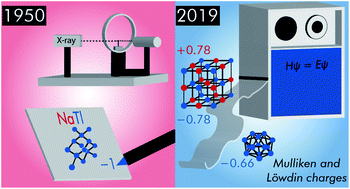Chemically understanding the electronic structure of a given material provides valuable information about its chemical as well as physical nature and, hence, is the key to designing materials with desired properties. For example, to rationalize the structures of solid-state materials in terms of the valence-electron distribution, highly schematic, essentially non-quantum-mechanical electron-partitioning models such as the Zintl–Klemm concept have been introduced by assuming idealized ionic charges. To go beyond the limits of the aforementioned concept, a Mulliken and Löwdin population analytical tool has been developed to accurately calculate the charges in solid-state materials solely from first-principles plane-wave-based computations. This population analysis tool, which has been implemented into the LOBSTER code, has been applied to diverse solid-state materials including polar intermetallics to prove its capability, including quick access to Madelung energies. In addition, a former weakness of the population analysis (namely, the basis-set dependency) no longer exists for the present approach which therefore represents a comparatively fast and accurate wave-function-based alternative for plane-wave calculations for which density-based charge approaches (e.g., Bader like) have been very popular.

